Effect of Nitrogen on Growth and Optical Properties of Single-Crystal Diamond Synthesized by Chemical Vapor Deposition
Abstract
:1. Introduction
2. Materials and Methods
3. Results and Discussion
4. Conclusions
Supplementary Materials
Author Contributions
Funding
Institutional Review Board Statement
Informed Consent Statement
Data Availability Statement
Conflicts of Interest
References
- Yang, N.; Yu, S.; MacPherson, J.V.; Einaga, Y.; Zhao, H.; Zhao, G.; Swain, G.M.; Jiang, X. Conductive diamond: Synthesis, properties, and electrochemical applications. Chem. Soc. Rev. 2019, 48, 157–204. [Google Scholar] [CrossRef]
- Liao, M. Progress in semiconductor diamond photodetectors and MEMS sensors. Funct. Diam. 2021, 1, 29–46. [Google Scholar] [CrossRef]
- Liwen, S. Diamond as the heat spreader for the thermal dissipation of GaN-based electronic devices. Funct. Diam. 2021, 1, 174–188. [Google Scholar] [CrossRef]
- Teraji, T.; Ito, T. Homoepitaxial diamond growth by high-power microwave-plasma chemical vapor deposition. J. Cryst. Growth 2004, 271, 409–419. [Google Scholar] [CrossRef]
- Teraji, T.; Hamada, M.; Wada, H.; Yamamoto, M.; Arima, K.; Ito, T. High rate growth and electrical/optical properties of high-quality homoepitaxial diamond (100) films. Diam. Relat. Mater. 2005, 14, 255–260. [Google Scholar] [CrossRef]
- Yan, C.S.; Vohra, Y.K.; Mao, H.K.; Hemley, R.J. Very high growth rate chemical vapor deposition of single-crystal diamond. Proc. Natl. Acad. Sci. USA 2002, 99, 12523–12525. [Google Scholar] [CrossRef]
- Chayahara, A.; Mokuno, Y.; Horino, Y.; Takasu, Y.; Kato, H.; Yoshikawa, H.; Fujimori, N. The effect of nitrogen addition during high-rate homoepitaxial growth of diamond by microwave plasma CVD. Diam. Relat. Mater. 2004, 13, 1954–1958. [Google Scholar] [CrossRef]
- Bohr, S.; Haubner, R.; Lux, B. Influence of nitrogen additions on hot-filament chemical vapor deposition of diamond. Appl. Phys. Lett. 1996, 68, 1075–1077. [Google Scholar] [CrossRef]
- Zaitsev, A.M.; Wang, W.; Moe, K.S.; Johnson, P. Spectroscopic studies of yellow nitrogen-doped CVD diamonds. Diam. Relat. Mater. 2016, 68, 51–61. [Google Scholar] [CrossRef]
- Liang, Q.; Chin, C.Y.; Lai, J.; Yan, C.S.; Meng, Y.; Mao, H.K.; Hemley, R.J. Enhanced growth of high quality single crystal diamond by microwave plasma assisted chemical vapor deposition at high gas pressures. Appl. Phys. Lett. 2009, 94, 024103. [Google Scholar] [CrossRef]
- Yamamoto, Y.; Imai, T.; Tanabe, K.; Tsuno, T.; Kumazawa, Y.; Fujimori, N. The measurement of thermal properties of diamond. Diam. Relat. Mater. 1997, 6, 1057–1061. [Google Scholar] [CrossRef]
- Ralchenko, V.; Pimenov, S.; Konov, V.; Khomich, A.; Saveliev, A.; Popovich, A.; Vlasov, I. Nitrogenated nanocrystalline diamond films: Thermal and optical properties. Diam. Relat. Mater. 2007, 16, 2067–2073. [Google Scholar] [CrossRef]
- Cao, G.Z.; Schermer, J.J.; Van Enckevort, W.J.P.; Elst, W.A.L.M.; Giling, L.J. Growth of {100} textured diamond films by the addition of nitrogen. J. Appl. Phys. 1996, 79, 1357–1364. [Google Scholar] [CrossRef]
- Dunst, S.; Sternschulte, H.; Schreck, M. Growth rate enhancement by nitrogen in diamond chemical vapor deposition-a catalytic effect. Appl. Phys. Lett. 2009, 94, 224101. [Google Scholar] [CrossRef]
- Achard, J.; Silva, F.; Tallaire, A.; Bonnin, X.; Lombardi, G.; Hassouni, K.; Gicquel, A. High quality MPACVD diamond single crystal growth: High microwave power density regime. J. Phys. D Appl. Phys. 2007, 40, 6175–6188. [Google Scholar] [CrossRef]
- Tallaire, A.; Collins, A.T.; Charles, D.; Achard, J.; Sussmann, R.; Gicquel, A.; Newton, M.E.; Edmonds, A.M.; Cruddace, R.J. Characterisation of high-quality thick single-crystal diamond grown by CVD with a low nitrogen addition. Diam. Relat. Mater. 2006, 15, 1700–1707. [Google Scholar] [CrossRef]
- Khomich, A.P.B.A.A.; Kudryavtsev, O.S.; Khomich, V.I.K.A.V.; Ashkinazi, E.E.; Ralchenko, V.G.; Vlasov, I.I. Use of optical spectroscopy methods to determine the solubility limit for nitrogen in diamond single crystals synthesized by chemical vapor deposition. J. Appl. Spectrosc. 2015, 82, 248–253. [Google Scholar] [CrossRef]
- Yiming, Z.; Larsson, F.; Larsson, K. Effect of CVD diamond growth by doping with nitrogen. Theor. Chem. Acc. 2014, 133, 1432. [Google Scholar] [CrossRef]
- Gueorguiev, G.K.; Broitman, E.; Furlan, A.; Stafström, S.; Hultman, L. Dangling bond energetics in carbon nitride and phosphorus carbide thin films with fullerene-like and amorphous structure. Chem. Phys. Lett. 2009, 482, 110–113. [Google Scholar] [CrossRef]
- Broitman, E.; Furlan, A.; Geuorguiev, G.K.; Czigány, Z.; Högberg, H.; Hultman, L. Structural and Mechanical Properties of CNx and CPx Thin Solid Films. Key Eng. Mater. 2012, 488, 581–584. [Google Scholar] [CrossRef]
- Van Regemorter, T.; Larsson, K. A theoretical study of nitrogen-induced effects on initial steps of diamond CVD growth. Chem. Vap. Depos. 2008, 14, 224–231. [Google Scholar] [CrossRef]
- Van Regemorter, T.; Larsson, K. Effect of substitutional N on the diamond CVD growth process: A theoretical approach. Diam. Relat. Mater. 2008, 17, 1076–1079. [Google Scholar] [CrossRef]
- Van Enckevort, W.J.P.; Janssen, G.; Schermer, J.J.; Giling, L.J. Step-related growth phenomena on exact and misoriented {001} surfaces of CVD-grown single-crystal diamonds. Diam. Relat. Mater. 1995, 4, 250–255. [Google Scholar] [CrossRef]
- Naamoun, M.; Tallaire, A.; Doppelt, P.; Gicquel, A.; Legros, M.; Barjon, J.; Achard, J. Reduction of dislocation densities in single crystal CVD diamond by using self-assembled metallic masks. Diam. Relat. Mater. 2015, 58, 62–68. [Google Scholar] [CrossRef]
- Achard, J.; Silva, F.; Brinza, O.; Tallaire, A.; Gicquel, A. Coupled effect of nitrogen addition and surface temperature on the morphology and the kinetics of thick CVD diamond single crystals. Diam. Relat. Mater. 2007, 16, 685–689. [Google Scholar] [CrossRef]
- Müller-Sebert, W.; Wörner, E.; Fuchs, F.; Wild, C.; Koidl, P. Nitrogen induced increase of growth rate in chemical vapor deposition of diamond. Appl. Phys. Lett. 1996, 68, 759–760. [Google Scholar] [CrossRef]
- Frauenheim, T.; Jungnickel, G.; Sitch, P.; Kaukonen, M.; Weich, F.; Widany, J.; Porezag, D. A molecular dynamics study of N-incorporation into carbon systems: Doping, diamond growth and nitride formation. Diam. Relat. Mater. 1998, 7, 348–355. [Google Scholar] [CrossRef]
- Charles, S.J.; Butler, J.E.; Feygelson, B.N.; Newton, M.E.; Carroll, D.L.; Steeds, J.W.; Darwish, H.; Yan, C.S.; Mao, H.K.; Hemley, R.J. Characterization of nitrogen doped chemical vapor deposited single crystal diamond before and after high pressure, high temperature annealing. Phys. Status Solidi Appl. Res. 2004, 201, 2473–2485. [Google Scholar] [CrossRef]
- Qi, X.G.; Chen, Z.S.; Xu, H. Construction and analysis of C-H-N phase diagram for diamond chemical vapor deposition by simulation of gas-phase chemistry. Surf. Coat. Technol. 2006, 200, 5268–5276. [Google Scholar] [CrossRef]
- Beha, K.; Batalov, A.; Manson, N.B.; Bratschitsch, R.; Leitenstorfer, A. Optimum Photoluminescence Excitation and Recharging Cycle of Single Nitrogen-Vacancy Centers in Ultrapure Diamond. Phys. Rev. Lett. 2012, 109, 097404. [Google Scholar] [CrossRef]
- Tallaire, A.; Brinza, O.; Huillery, P.; Delord, T.; Pellet-Mary, C.; Staacke, R.; Abel, B.; Pezzagna, S.; Meijer, J.; Touati, N.; et al. High NV density in a pink CVD diamond grown with N2O addition. Carbon 2020, 170, 421–429. [Google Scholar] [CrossRef]
- Anthony, T.R. Stresses generated by impurities in diamond. Diam. Relat. Mater. 1995, 4, 1346–1352. [Google Scholar] [CrossRef]
- Yan, B.; Jia, X.; Fang, C.; Chen, N.; Li, Y.; Sun, S.; Ma, H.A. The effect of phosphorus and nitrogen co-doped on the synthesis of diamond at high pressure and high temperature. Int. J. Refract. Met. Hard Mater. 2016, 54, 309–314. [Google Scholar] [CrossRef]
- Balasubramanian, P.; Osterkamp, C.; Brinza, O.; Rollo, M.; Robert-philip, I.; Goldner, P.; Jacques, V.; Jelezko, F.; Achard, J.; Tallaire, A. Enhancement of the creation yield of NV ensembles in a chemically vapour deposited diamond. Carbon 2022, 194, 282–289. [Google Scholar] [CrossRef]
- Bolshakov, A.P.; Ralchenko, V.G.; Shu, G.; Dai, B.; Yurov, V.Y.; Bushuev, E.V.; Khomich, A.A.; Altakhov, A.S.; Ashkinazi, E.E.; Antonova, I.A.; et al. Single crystal diamond growth by MPCVD at subatmospheric pressures. Mater. Today Commun. 2020, 25, 101635. [Google Scholar] [CrossRef]
- Singh, S.; Catledge, S.A.; Singh, S.; Catledge, S.A. Silicon vacancy color center photoluminescence enhancement in nanodiamond particles by isolated substitutional nitrogen on {100} surfaces. J. Appl. Phys. 2013, 113, 044701. [Google Scholar] [CrossRef]
- Li, H.-D.; Zou, G.-T.; Wang, Q.-L.; Cheng, S.-H.; Li, B.; Lü, J.-N.; Lü, X.-Y.; Jin, Z.-S. High-Rate Growth and Nitrogen Distribution in Homoepitaxial Chemical Vapour Deposited Single-crystal Diamond. Chin. Phys. Lett. 2008, 25, 1803–1806. [Google Scholar] [CrossRef]
- Bernholc, J.; Antonelli, A.; Del Sole, T.M.; Bar-Yam, Y.; Pantelides, S.T. Mechanism of self-diffusion in diamond. Phys. Rev. Lett. 1988, 61, 2689–2692. [Google Scholar] [CrossRef] [PubMed]
- Collins, A.T. Vacancy enhanced aggregation of nitrogen in diamond. J. Phys. C Solid State Phys. 1980, 13, 2641–2650. [Google Scholar] [CrossRef]
- Mokuno, Y.; Chayahara, A.; Soda, Y.; Yamada, H.; Horino, Y.; Fujimori, N. High rate homoepitaxial growth of diamond by microwave plasma CVD with nitrogen addition. Diam. Relat. Mater. 2006, 15, 455–459. [Google Scholar] [CrossRef]
- Chen, L.; Miao, X.; Ma, H.; Guo, L.; Wang, Z.; Yang, Z.; Fang, C.; Jia, X.P. Synthesis and characterization of diamonds with different nitrogen concentrations under high pressure and high temperature conditions. CrystEngComm 2018, 20, 7164–7169. [Google Scholar] [CrossRef]
- Bar-Yam, Y.; Moustakas, T.D. Defect-induced stabilization of diamond films. Nature 1989, 342, 786–787. [Google Scholar] [CrossRef]
- Tallaire, A.; Lesik, M.; Jacques, V.; Pezzagna, S.; Mille, V.; Brinza, O.; Meijer, J.; Abel, B.; Roch, J.F.; Gicquel, A.; et al. Temperature dependent creation of nitrogen-vacancy centers in single crystal CVD diamond layers. Diam. Relat. Mater. 2015, 51, 55–60. [Google Scholar] [CrossRef]
- Fan, Y.; Fitzgerald, A.G.; John, P.; Troupe, C.E.; Wilson, J.I.B. X-ray photoelectron spectroscopy studies of CVD diamond films. Surf. Interface Anal. 2002, 34, 703–707. [Google Scholar] [CrossRef]
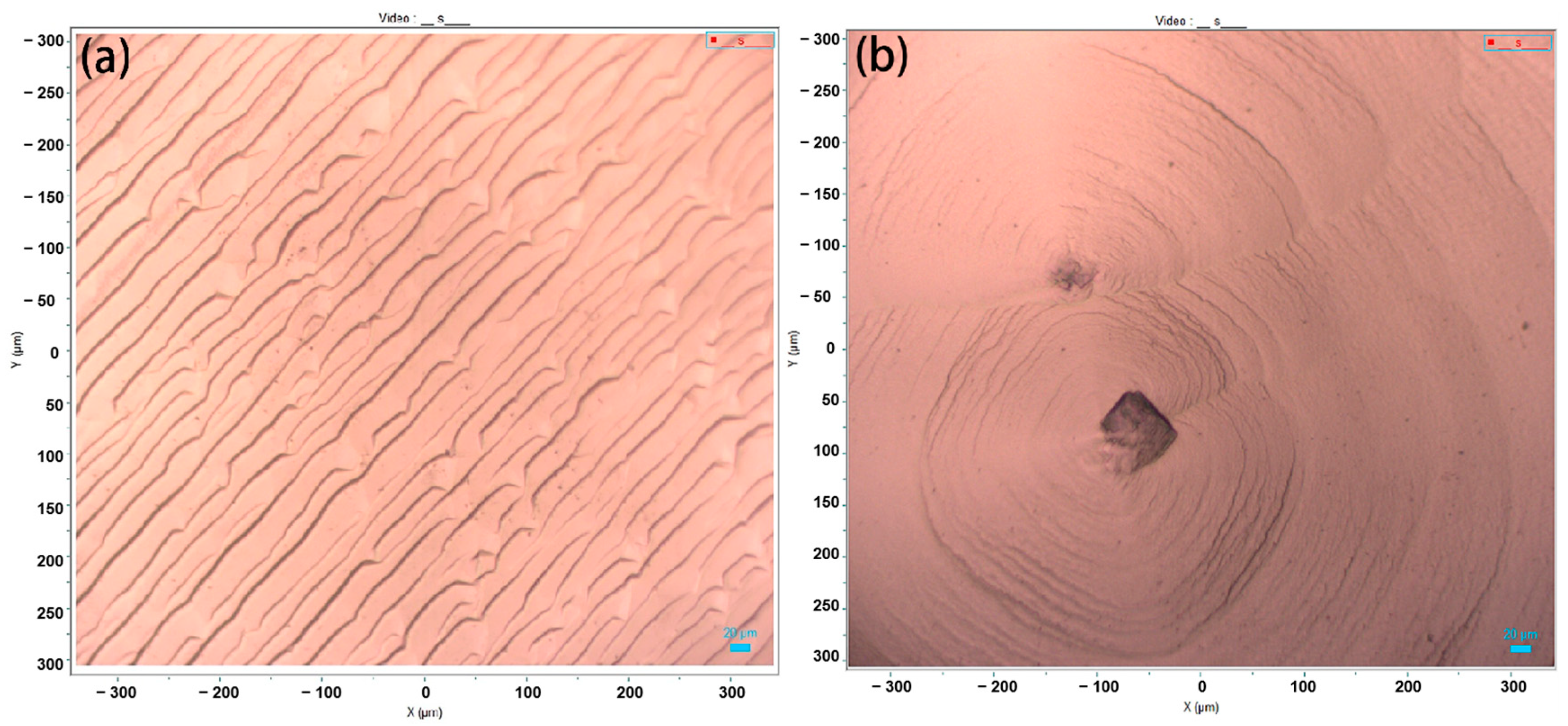
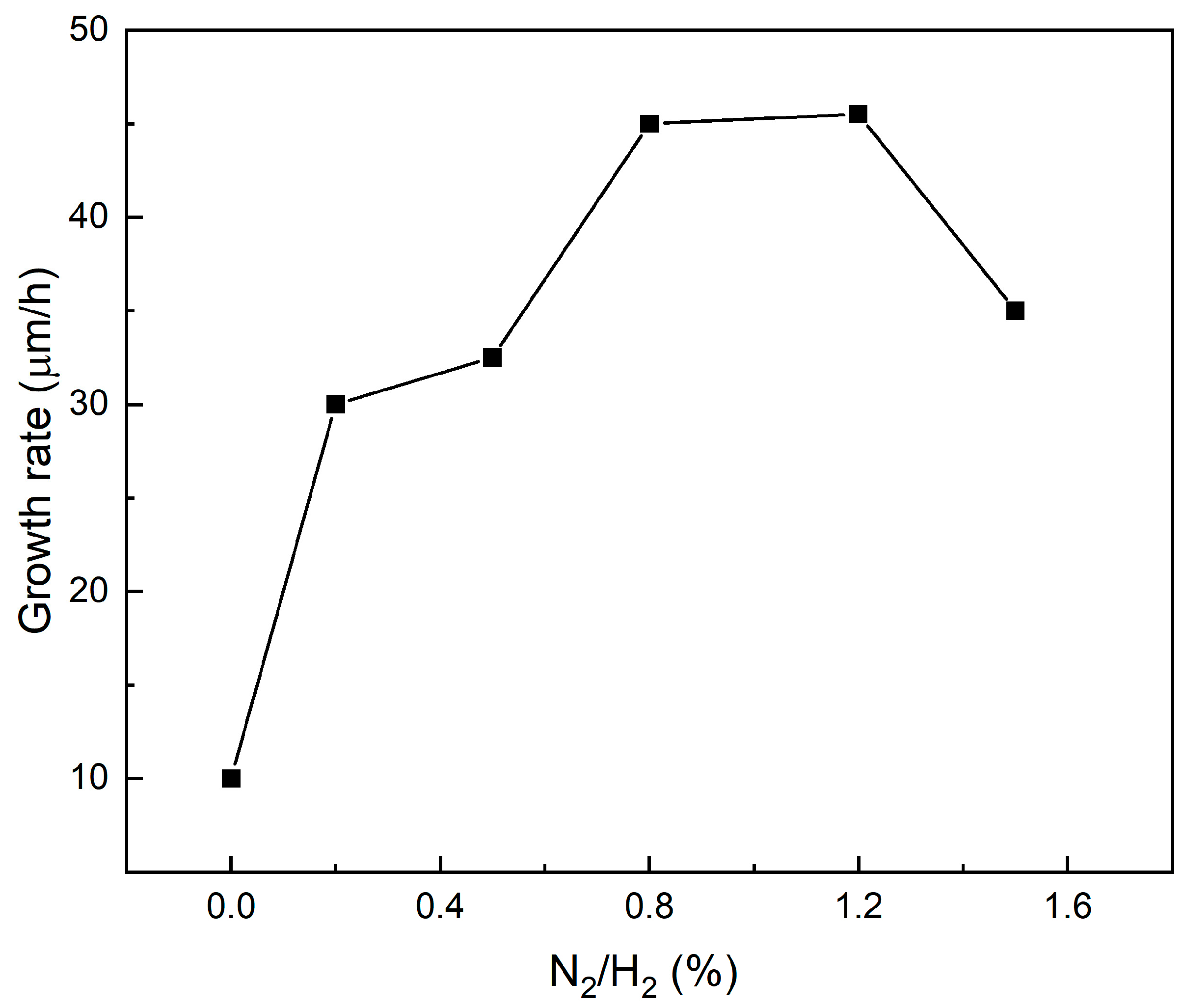
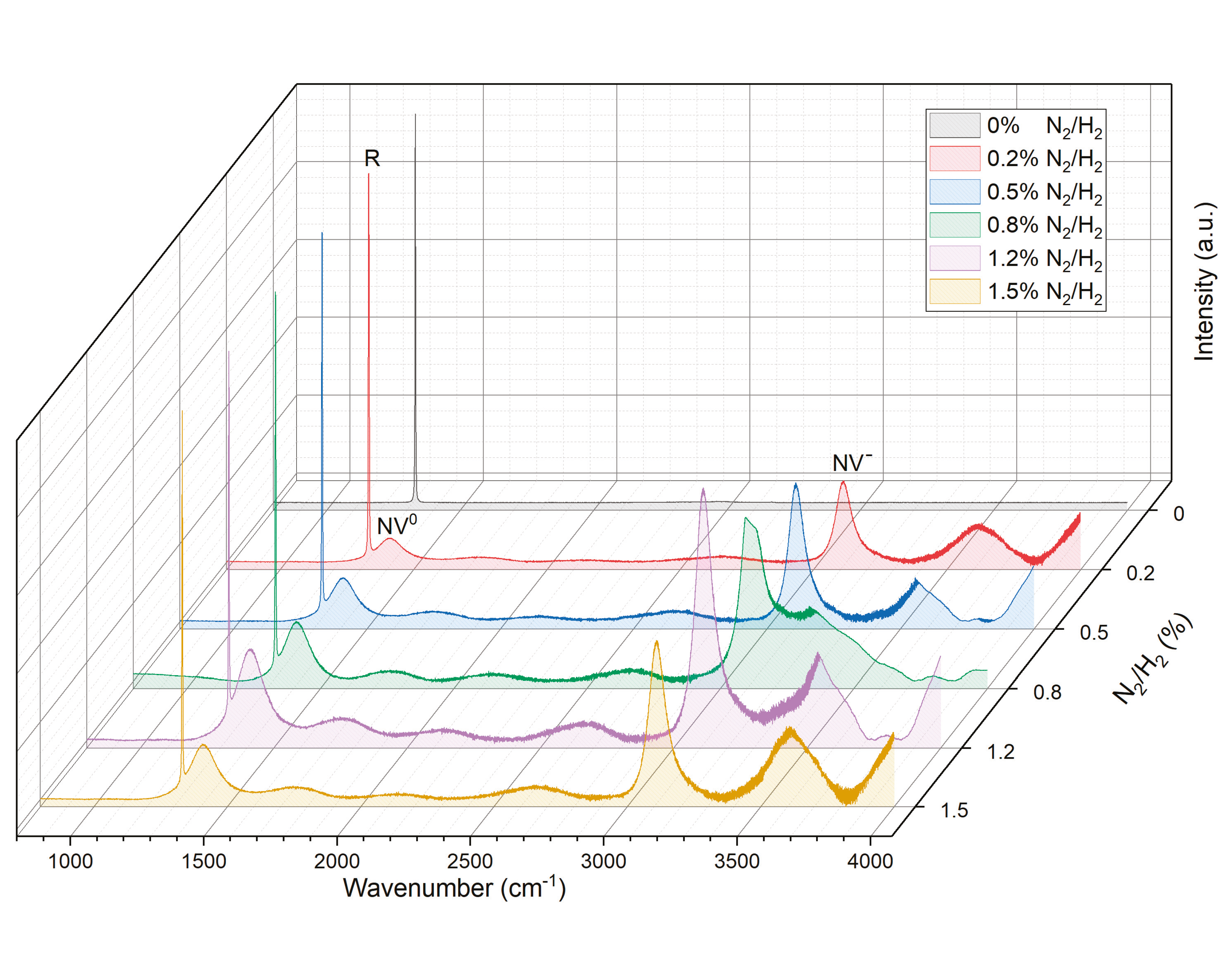

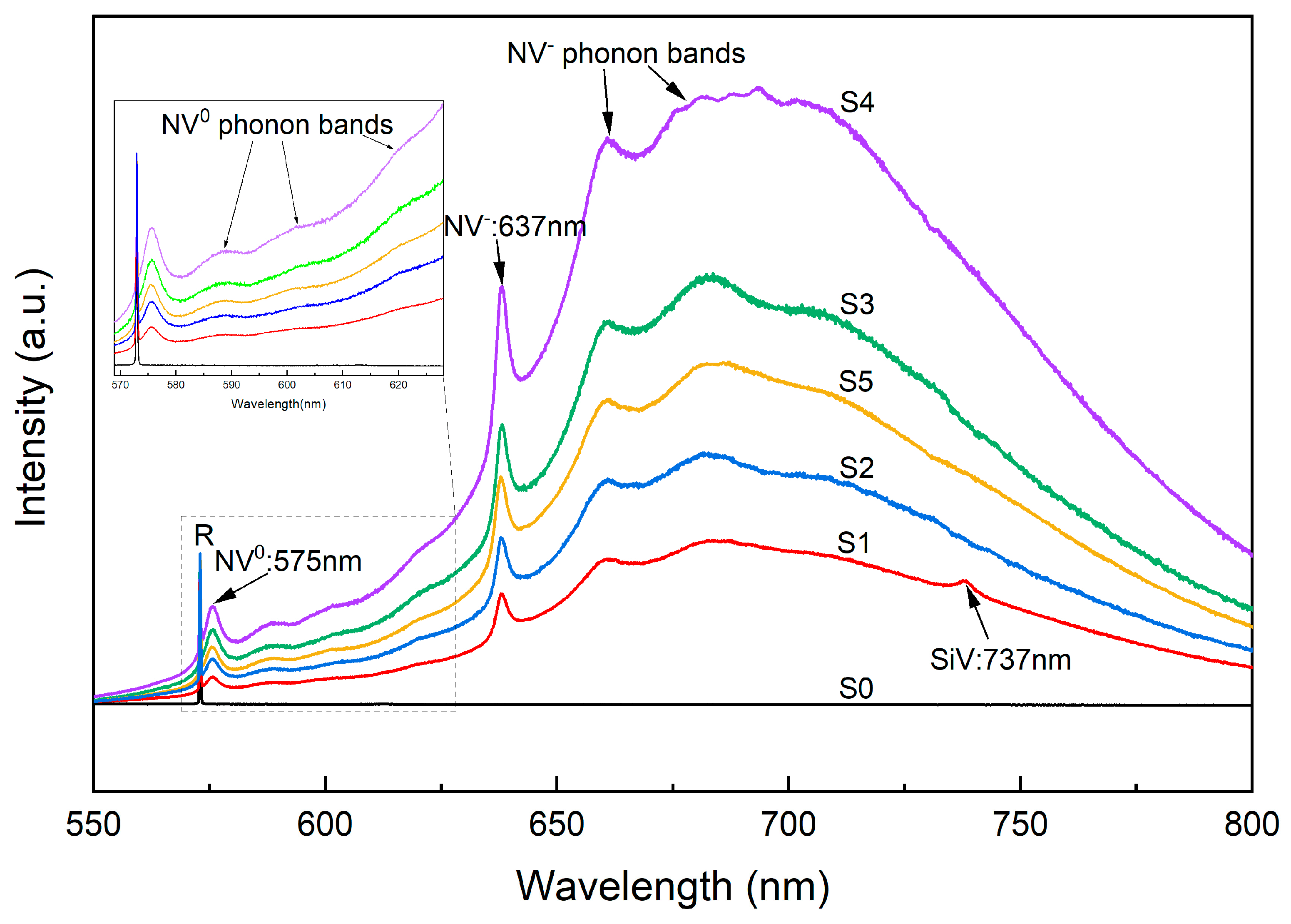
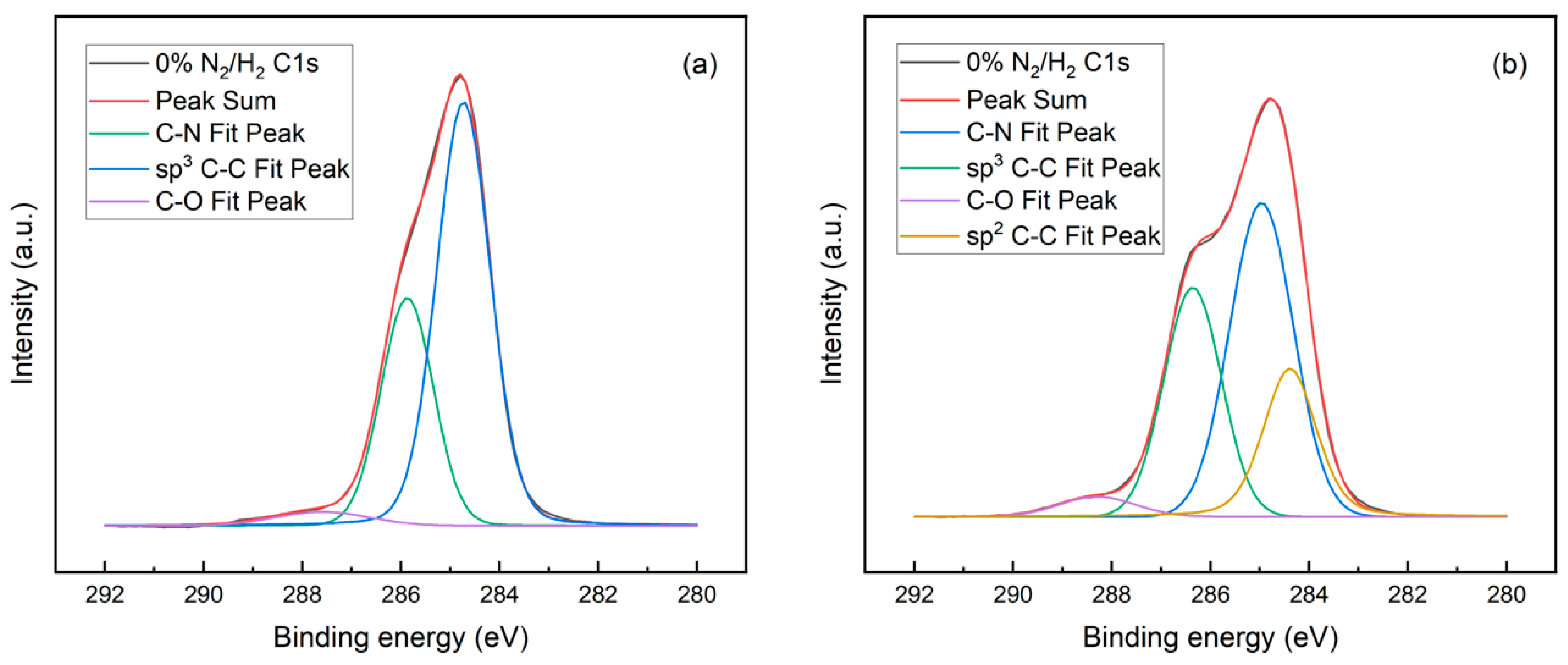
| Samples | Level of Nitrogen Doping (N2/H2)/% | CH4 Flow Rates/sccm | Time/h | Temperature/°C | Power/kW | Pressure/kPa |
|---|---|---|---|---|---|---|
| S0 | 0 | 24 | 4 | ~950 | ~3.25 | ~13 |
| S1 | 0.2 | |||||
| S2 | 0.5 | |||||
| S3 | 0.8 | |||||
| S4 | 1.2 | |||||
| S5 | 1.5 |
Disclaimer/Publisher’s Note: The statements, opinions and data contained in all publications are solely those of the individual author(s) and contributor(s) and not of MDPI and/or the editor(s). MDPI and/or the editor(s) disclaim responsibility for any injury to people or property resulting from any ideas, methods, instructions or products referred to in the content. |
© 2024 by the authors. Licensee MDPI, Basel, Switzerland. This article is an open access article distributed under the terms and conditions of the Creative Commons Attribution (CC BY) license (https://creativecommons.org/licenses/by/4.0/).
Share and Cite
Ren, Y.; Lv, W.; Li, X.; Dong, H.; Wöhrl, N.; Yang, X.; Li, Z.; Wang, T. Effect of Nitrogen on Growth and Optical Properties of Single-Crystal Diamond Synthesized by Chemical Vapor Deposition. Materials 2024, 17, 1311. https://doi.org/10.3390/ma17061311
Ren Y, Lv W, Li X, Dong H, Wöhrl N, Yang X, Li Z, Wang T. Effect of Nitrogen on Growth and Optical Properties of Single-Crystal Diamond Synthesized by Chemical Vapor Deposition. Materials. 2024; 17(6):1311. https://doi.org/10.3390/ma17061311
Chicago/Turabian StyleRen, Ying, Wei Lv, Xiaogang Li, Haoyong Dong, Nicolas Wöhrl, Xun Yang, Zhengxin Li, and Tao Wang. 2024. "Effect of Nitrogen on Growth and Optical Properties of Single-Crystal Diamond Synthesized by Chemical Vapor Deposition" Materials 17, no. 6: 1311. https://doi.org/10.3390/ma17061311





